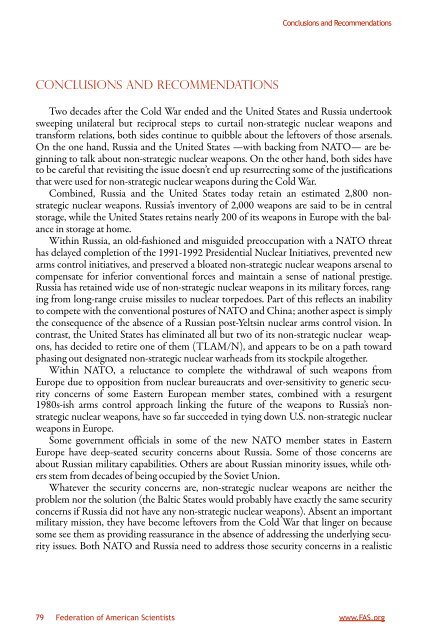Non Strategic Nuclear Weapons - Federation of American Scientists
Non Strategic Nuclear Weapons - Federation of American Scientists
Non Strategic Nuclear Weapons - Federation of American Scientists
You also want an ePaper? Increase the reach of your titles
YUMPU automatically turns print PDFs into web optimized ePapers that Google loves.
CONCLUSIONS AND RECOMMENDATIONS<br />
Conclusions and Recommendations<br />
Two decades after the Cold War ended and the United States and Russia undertook<br />
sweeping unilateral but reciprocal steps to curtail non-strategic nuclear weapons and<br />
transform relations, both sides continue to quibble about the leftovers <strong>of</strong> those arsenals.<br />
On the one hand, Russia and the United States —with backing from NATO— are beginning<br />
to talk about non-strategic nuclear weapons. On the other hand, both sides have<br />
to be careful that revisiting the issue doesn’t end up resurrecting some <strong>of</strong> the justifications<br />
that were used for non-strategic nuclear weapons during the Cold War.<br />
Combined, Russia and the United States today retain an estimated 2,800 nonstrategic<br />
nuclear weapons. Russia’s inventory <strong>of</strong> 2,000 weapons are said to be in central<br />
storage, while the United States retains nearly 200 <strong>of</strong> its weapons in Europe with the balance<br />
in storage at home.<br />
Within Russia, an old-fashioned and misguided preoccupation with a NATO threat<br />
has delayed completion <strong>of</strong> the 1991-1992 Presidential <strong>Nuclear</strong> Initiatives, prevented new<br />
arms control initiatives, and preserved a bloated non-strategic nuclear weapons arsenal to<br />
compensate for inferior conventional forces and maintain a sense <strong>of</strong> national prestige.<br />
Russia has retained wide use <strong>of</strong> non-strategic nuclear weapons in its military forces, ranging<br />
from long-range cruise missiles to nuclear torpedoes. Part <strong>of</strong> this reflects an inability<br />
to compete with the conventional postures <strong>of</strong> NATO and China; another aspect is simply<br />
the consequence <strong>of</strong> the absence <strong>of</strong> a Russian post-Yeltsin nuclear arms control vision. In<br />
contrast, the United States has eliminated all but two <strong>of</strong> its non-strategic nuclear weapons,<br />
has decided to retire one <strong>of</strong> them (TLAM/N), and appears to be on a path toward<br />
phasing out designated non-strategic nuclear warheads from its stockpile altogether.<br />
Within NATO, a reluctance to complete the withdrawal <strong>of</strong> such weapons from<br />
Europe due to opposition from nuclear bureaucrats and over-sensitivity to generic security<br />
concerns <strong>of</strong> some Eastern European member states, combined with a resurgent<br />
1980s-ish arms control approach linking the future <strong>of</strong> the weapons to Russia’s nonstrategic<br />
nuclear weapons, have so far succeeded in tying down U.S. non-strategic nuclear<br />
weapons in Europe.<br />
Some government <strong>of</strong>ficials in some <strong>of</strong> the new NATO member states in Eastern<br />
Europe have deep-seated security concerns about Russia. Some <strong>of</strong> those concerns are<br />
about Russian military capabilities. Others are about Russian minority issues, while others<br />
stem from decades <strong>of</strong> being occupied by the Soviet Union.<br />
Whatever the security concerns are, non-strategic nuclear weapons are neither the<br />
problem nor the solution (the Baltic States would probably have exactly the same security<br />
concerns if Russia did not have any non-strategic nuclear weapons). Absent an important<br />
military mission, they have become leftovers from the Cold War that linger on because<br />
some see them as providing reassurance in the absence <strong>of</strong> addressing the underlying security<br />
issues. Both NATO and Russia need to address those security concerns in a realistic<br />
79 <strong>Federation</strong> <strong>of</strong> <strong>American</strong> <strong>Scientists</strong> www.FAS.org
















